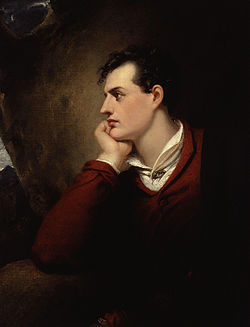George Byron
| The Right Honourable The Lord Byron FRS |
|
|---|---|

Portrait of Lord Byron by Richard Westall
|
|
| Born | George Gordon Byron 22 January 1788 London, England |
| Died | 19 April 1824 (aged 36) Missolonghi, Aetolia, Ottoman Empire (present-day Aetolia-Acarnania, Greece) |
| Resting place | Church of St. Mary Magdalene, Hucknall, Nottinghamshire. |
| Occupation | Poet, Politician |
| Nationality | English |
| Alma mater | Trinity College, Cambridge |
| Literary movement | Romanticism |
| Notable works |
|
| Spouse | Anne Isabella Milbanke (m. 1815; div. 1816) |
| Partner | Claire Clairmont |
| Children |
Ada, Countess of Lovelace Allegra Byron |
|
|
|
| Signature |  |
|
Member of the House of Lords Lord Temporal |
|
|
In office 21 May 1798 – 19 April 1824 Hereditary Peerage |
|
| Preceded by | William Byron |
| Succeeded by | George Byron |
George Gordon Byron, 6th Baron Byron, FRS (22 January 1788 – 19 April 1824), commonly known simply as Lord Byron, was a British poet, peer, politician, and a leading figure in the Romantic movement. Among his best-known works are the lengthy narrative poems, Don Juan and Childe Harold's Pilgrimage, and the short lyric poem, "She Walks in Beauty".
Byron is regarded as one of the greatest British poets and remains widely read and influential. He travelled extensively across Europe, especially in Italy, where he lived for seven years with the struggling poet Percy Bysshe Shelley. Later in his brief life, Byron joined the Greek War of Independence fighting the Ottoman Empire, for which Greeks revere him as a national hero.
He died in 1824 at the age of 36 from a fever contracted while in Missolonghi. Often described as the most flamboyant and notorious of the major Romantics, Byron was both celebrated and castigated in life for his aristocratic excesses, including huge debts, numerous love affairs – with men as well as women, as well as rumours of a scandalous liaison with his half-sister – and self-imposed exile.
He also fathered Ada, Countess of Lovelace, whose work on Charles Babbage's Analytical Engine is considered a founding document in the field of computer science, and Allegra Byron, who died in childhood – as well as, possibly, Elizabeth Medora Leigh out of wedlock.
Ethel Colburn Mayne states that George Gordon Byron was born on 22 January 1788 in a house on 24 Holles Street in London. However, Robert Charles Dallas in his Recollections states that Byron was born in Dover.
...
Wikipedia
